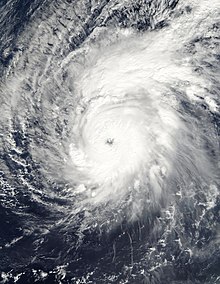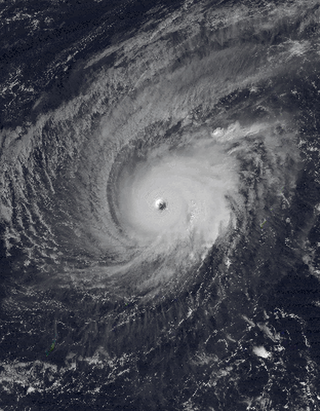
Typhoon Paka, known in the Philippines as Typhoon Rubing, was the last tropical cyclone of the 1997 Pacific hurricane and typhoon season, and was among the strongest Pacific typhoons in the month of December. Paka, which is the Hawaiian name for Pat, developed on November 28 from a trough well to the southwest of Hawaii. The storm tracked generally westward for much of its duration, and on December 7 it crossed into the western Pacific Ocean. Much of its track was characterized by fluctuations in intensity, and on December 10 the cyclone attained typhoon status as it crossed the Marshall Islands. On December 16, Paka struck Guam and Rota with winds of 230 km/h (140 mph), and it strengthened further to reach peak winds on December 18 over open waters as the final super typhoon of the year. Subsequently, it underwent a steady weakening trend, and on December 23 Paka dissipated.

The 2002 Pacific typhoon season was a slightly above average Pacific typhoon season, producing twenty-six named storms, fifteen becoming typhoons, and eight super typhoons. It had one of the highest ACE of any season worldwide, with over 400 units. It was an event in the annual cycle of tropical cyclone formation, in which tropical cyclones form in the western Pacific Ocean. The season ran throughout 2002, though most tropical cyclones typically develop between May and October. The season's first named storm, Tapah, developed on January 11, while the season's last named storm, Pongsona, dissipated on December 11. The season's first typhoon, Mitag, reached typhoon status on March 1, and became the first super typhoon of the year four days later.

The 1997 Pacific typhoon season was a record-breaking season featuring 11 tropical cyclones reaching super typhoon intensity, tying the record with 1965 with the most violent tropical cyclones globally, and was the ninth and last consecutive year of above-average tropical cyclone activity that started in 1989. It has no official bounds; it ran year-round in 1997, but most tropical cyclones tend to form in the northwestern Pacific Ocean between May and November. These dates conventionally delimit the period of each year when most tropical cyclones form in the northwestern Pacific Ocean.

Typhoon Chataan, known in the Philippines as Typhoon Gloria, was the deadliest natural disaster in the history of Chuuk, a state in the Federated States of Micronesia (FSM). The typhoon formed on June 28, 2002, near the FSM, and for several days it meandered while producing heavy rainfall across the region. On Chuuk, the highest 24-hour precipitation total was 506 mm (19.9 in), which was greater than the average monthly total. The rain produced floods up to 1.5 m (4.9 ft) deep, causing landslides across the island that killed 47 people. There was also one death on nearby Pohnpei, and damage in the FSM totaled over $100 million.
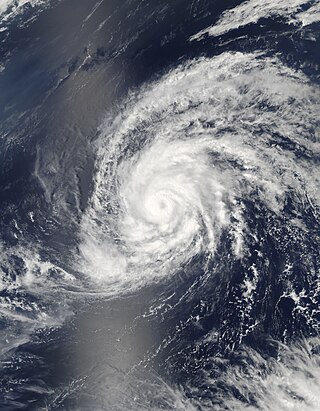
Typhoon Kong-rey was a moderate typhoon that affected Guam and the Northern Mariana Islands in early April 2007. The first named storm of the 2007 Pacific typhoon season, Kong-rey became the earliest-occurring typhoon since Typhoon Sudal in 2004. At its peak, it was considered to be a Category 2-equivalent typhoon by the Joint Typhoon Warning Center, though re-analysis increased it to a Category 3-equivalent. Typhoon Kong-rey caused about $10,000 in damages and no injuries along its path.

Typhoon Isa was the first of a record eleven super typhoons to occur during the 1997 Pacific typhoon season. The second tropical cyclone of the season, Isa developed from a disturbance in the monsoon trough near the Caroline Islands on April 12. It moved erratically at first, though after attaining tropical storm status it curved westward due to the subtropical ridge to its north. Isa very gradually intensified, and on April 20 the typhoon reached peak 1-min winds of 270 km/h (170 mph), as reported by the Joint Typhoon Warning Center; Japan Meteorological Agency reported maximum 10-min winds of 155 km/h (95 mph). After turning northward, it accelerated to the northeast, and merged with a larger extratropical cyclone on April 24.
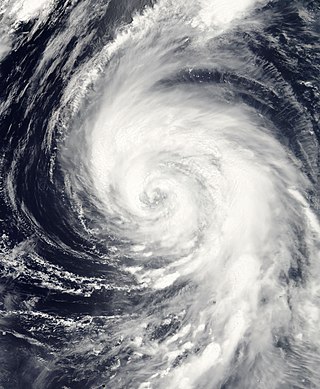
Typhoon Tingting was a destructive tropical cyclone that produced record-breaking rains in Guam. The eighth named storm of the 2004 Pacific typhoon season, Tingting originated from a tropical depression over the open waters of the western Pacific Ocean. The storm gradually intensified as it traveled northwest, becoming a typhoon on June 28 and reaching its peak the following day while passing through the Mariana Islands. After maintaining typhoon intensity for three days, a combination of dry air and cooler sea surface temperatures caused the storm to weaken as it traveled northward. On July 1, the storm passed by the Bonin Islands, off the coast of Japan, before moving out to sea. By July 4, Tinting had transitioned into an extratropical cyclone. The remnants were last reported by the Japan Meteorological Agency, the Regional Specialized Meteorological Center for the western Pacific basin, near the International Date Line on July 13.

Tropical Depression 18W was a weak, short-lived tropical cyclone that brought heavy rains to parts of the Mariana Islands ahead of the more intense Typhoon Melor. Forming from an area of low pressure on September 26, 18W was first monitored by the Japan Meteorological Agency (JMA) as a tropical depression. Tracking generally towards the west, deep convection gradually developed around the system and the Joint Typhoon Warning Center (JTWC) issued their first advisory on the depression early on September 28. Although the depression initially struggled to maintain deep convection, it eventually became better organized and was upgraded to a tropical storm on September 29 by the JTWC. Several hours after reaching this intensity, the system began to rapidly dissipate as its inflow and outflow were severely disrupted by two nearby storms, Parma to the west and Melor to the east. The cyclone fully dissipated near Guam early on September 30 before being absorbed by Typhoon Parma.

Typhoon Roy, known in the Philippines as Typhoon Asiang, was the second-most intense January tropical cyclone on record in the Western Pacific basin. Forming out of an area of disturbed weather on January 7, 1988, Roy quickly intensified as it moved through the Marshall Islands. By January 9, the storm intensified into a typhoon and attained its peak intensity the following day. At its peak, sustained winds reached 215 km/h (135 mph). Slight weakening took place before the storm moved through the Mariana Islands. Continuing westward, the system eventually struck the Philippines as a minimal typhoon before dissipating over the South China Sea on January 19.
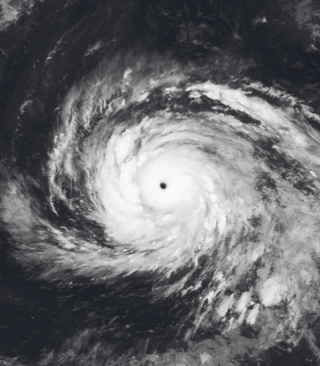
Typhoon Keith was the tenth of a record eleven super typhoons to develop during the unusually intense 1997 Pacific typhoon season. Originating from a near-equatorial trough on October 26, the precursor depression to Keith slowly organized into a tropical storm. After two days of gradual strengthening, the storm underwent a period of rapid intensification on October 30 as winds increased to 195 km/h (121 mph). On November 1, the storm further intensified into a super typhoon and later attained peak winds of 285 km/h (177 mph). The following day, the powerful storm passed between Rota and Tinian in the Northern Mariana Islands. After fluctuating in strength over the following few days, a steady weakening trend established itself by November 5 as the typhoon accelerated towards the northeast. On October 8, Keith transitioned into an extratropical cyclone and was last noted early the following day near the International Dateline.

Typhoon Sudal, known in the Philippines as Typhoon Cosme, was the strongest typhoon to strike the island of Yap in the Federated States of Micronesia (FSM) in about 50 years. Yap is one of the four administrative divisions of the FSM. The entire island, only 17 km (11 mi) in length, experienced typhoon force winds, and 90% of the structures were damaged or destroyed. Damage was most severe in southeastern Yap, where the eyewall struck and winds exceeded 185 km/h (115 mph), but the center of the typhoon passed south of the island.

Typhoon Lynn, more commonly known in the Philippines as Typhoon Pepang, was responsible for the worst flooding in Taiwan in 40 years. Typhoon Lynn originated from an area of disturbed weather in the central north Pacific in mid-October 1987. On October 15, the system was upgraded into a tropical storm. Moving west-northwest, it slowly deepened over the next few days, though the intensification process briefly stopped on October 15. Two days later, Lynn was upgraded into a typhoon, while passing northwest of Guam. Lynn maintained low-end typhoon strength until October 19, when the storm began to rapidly intensify. On October 21, Lynn attained its peak intensity while tracking towards the west. Weakening then commenced soon after Lynn interacted with Luzon. However, the core of the typhoon remained well offshore both the Philippines and Taiwan. On October 25, Lynn weakened to a severe tropical storm. Three days later, it dissipated, though its remains later brought rain to China.
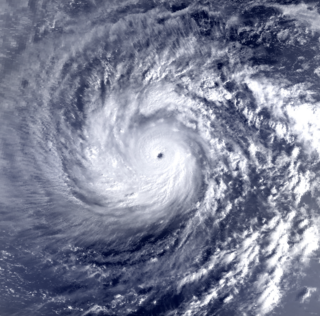
Typhoon Yuri was the most intense tropical cyclone in 1991 in terms of minimum central pressure. The nineteenth typhoon and final super typhoon of the 1991 Pacific typhoon season, Yuri was a tropical disturbance that strengthened into a tropical depression on November 22 in the Philippine Sea. Moving rather slowly at first, the system continued to intensify, and was given the name Yuri. It had become a severe tropical storm about 1,480 kilometers east of Truk Island and took on a west-northwestward track at 22 km/h. Typhoon intensity was attained that night when Yuri was 1,050 km. Yuri turned more to the west on 26 November and reached peak intensity the following morning packing winds of over 220 km/h near its centre. Moving northwestwards at 30 km/h, Yuri passed 140 km to the south-southwest of Guam on the evening of November 27. After recurving November 29, Yuri accelerated northeastwards on November 30 and weakened to a severe tropical storm that night. By the morning of December 1, it had degenerated into a tropical storm about a few hundred kilometers east-northeast of Iwo Jima. Extratropical transition was completed soon afterward, and the storm's remnants persisted until December 3.

Severe Tropical Storm Fern was a damaging storm that struck Yap in the 1996 Pacific typhoon season. A tropical depression formed on December 21, when a low-level circulation center began to produce deep convection. The depression strengthened into a tropical storm the next day, and was given the name Fern by the Joint Typhoon Warning Center (JTWC). The storm slowly intensified into a Category 1 typhoon on the Saffir–Simpson hurricane wind scale, according to JTWC. Fern peaked north of Yap on December 26, with JTWC assessing winds of 150 km/h (90 mph), while the Regional Specialized Meteorological Center, Japan Meteorological Agency (JMA) assessed peak winds of 110 km/h (70 mph), just below typhoon strength. The storm soon became sheared and weakened slowly. Fern continued to weaken to a tropical depression on December 30. Both agencies stopped advisories later on the same day.

Typhoon Dolphin was a powerful tropical cyclone that produced the first typhoon-force winds on Guam since Typhoon Pongsona in 2002. The seventh named storm of the 2015 Pacific typhoon season, Dolphin formed on May 6 in the vicinity of the Federated States of Micronesia (FSM). Moving eastward at first, the storm slowly organized before beginning a north and west-northwest trajectory. Dolphin intensified into a typhoon before passing between Guam and Rota on May 15, producing typhoon-force winds on both islands. It later rapidly intensified as it curved to the north. The American-based Joint Typhoon Warning Center (JTWC) designated Dolphin as a super typhoon, while the Japan Meteorological Agency (JMA) estimated 10 minute sustained winds of 185 km/h (115 mph). Dolphin turned to the northeast and weakened, becoming extratropical on May 20 and exiting the western Pacific basin on May 24.

Typhoon Yutu, known in the Philippines as Super Typhoon Rosita, was an extremely powerful tropical cyclone that caused catastrophic destruction on the islands of Tinian and Saipan in the Northern Mariana Islands, and later impacted the Philippines. It is the strongest typhoon ever recorded to impact the Mariana Islands, and is tied as the second-strongest tropical cyclone to strike the United States and its unincorporated territories by both wind speed and barometric pressure. It also tied Typhoon Kong-rey as the most powerful tropical cyclone worldwide in 2018. The fortieth tropical depression, twenty-sixth named storm, twelfth typhoon, and the seventh super typhoon of the 2018 Pacific typhoon season, Yutu originated from a low-pressure area that formed in the western Pacific Ocean on October 15. The disturbance organized into a tropical depression on the same day, as ocean sea-surface heat content increased. Shortly after becoming a tropical depression, the Joint Typhoon Warning Center (JTWC) assigned the system the identifier 31W. The system continued to strengthen, becoming a tropical storm several hours later, with the Japan Meteorological Agency (JMA) naming the system Yutu. Increasingly favorable conditions allowed Yutu to explosively intensify, as the system maintained deep convection and subsequently became a severe tropical storm and then a typhoon.

Typhoon Wutip, known in the Philippines as Tropical Depression Betty, was the most powerful February typhoon on record, surpassing Typhoon Higos of 2015. The third tropical cyclone, second tropical storm, and the first typhoon of the 2019 Pacific typhoon season, Wutip originated from a low-pressure area on February 16, 2019, that generally tracked westward, passing just south of the Federated States of Micronesia (FSM), before organizing into a tropical depression on February 18. The depression was later classified a tropical storm a day later, attaining the name Wutip from the Japan Meteorological Agency. The storm gradually intensified as it turned northwest, before it underwent rapid intensification on February 23, while passing to the southwest of Guam, and reached its first peak intensity. With winds of 270 km/h (165 mph) estimated by the Joint Typhoon Warning Center, Wutip became the first Category 5-equivalent super typhoon on record in the month of February. Wutip underwent an eyewall replacement cycle shortly afterward and weakened. The storm finished its cycle on February 24, rapidly intensifying once again. Wutip reached a secondary peak intensity the following day, again attaining Category 5-equivalent winds. Thereafter, Wutip rapidly weakened throughout its lifespan from strong wind shear as it moved northwestward, before dissipating over the Philippine Sea on March 2.

Typhoon Faxai was the most powerful tropical cyclone worldwide in 2001. The twenty-fourth named storm and the sixteenth typhoon of the 2001 Pacific typhoon season, Faxai originated from a circulation in the monsoon trough. The system remained stationary for several days near Kosrae, pouring heavy rain that knocked down power. An indirect death occurred on the island as well. As the storm steadily intensified, Faxai moved west-northwestward at a very slow pace as it neared Pingelap, damaging crops, before bringing strong winds and rainfall that produced two landslides in Pohnpei on December 20. Intensity fluctuated, but convection in the core became more defined and by December 21, Faxai had intensified into a typhoon. A period of rapid intensification then followed, and by early December 23, Faxai reached its peak intensity.

Typhoon Mawar, known in the Philippines as Super Typhoon Betty, was one of the strongest Northern Hemisphere tropical cyclones on record in the month of May, and is currently tied with Typhoon Bolaven as the strongest tropical cyclone worldwide in 2023 so far. The name "Mawar" means Rose in Malaysian. The second named storm, the first typhoon and the first super typhoon of the 2023 Pacific typhoon season, Mawar originated from an area of low pressure south-southwest of Chuuk Lagoon that developed into a tropical depression on May 19. It fluctuated in intensity and became a tropical storm, after which it intensified into a Category 4-equivalent super typhoon on the Saffir–Simpson hurricane wind scale. It then underwent an eyewall replacement cycle, then reintensified to attain 1-minute sustained winds of 295 km/h (185 mph) according to the JTWC, becoming a Category 5-equivalent super typhoon. Mawar weakened slightly as it moved around the southwestern edge of the subtropical high that made it steer north of the Philippines and then east of Taiwan. Mawar traversed the Okinawa Islands as a tropical storm, then transitioned into an extratropical cyclone as it moved northeastward out to sea, where it later dissipated east of Kamchatka Peninsula.
